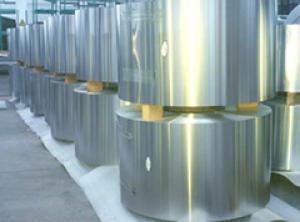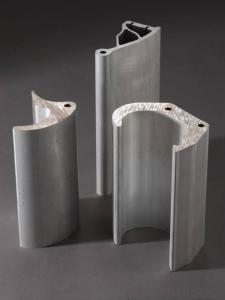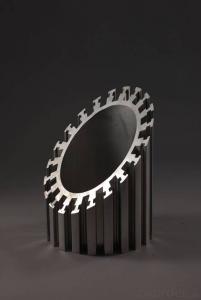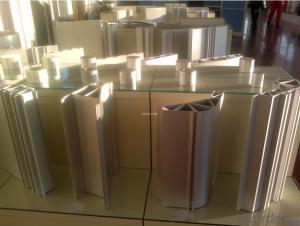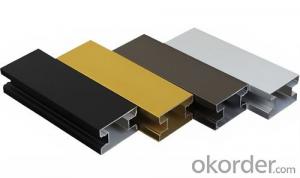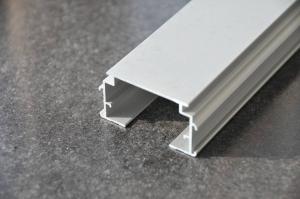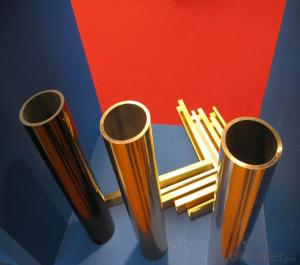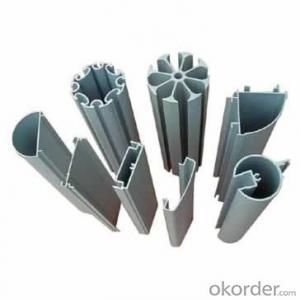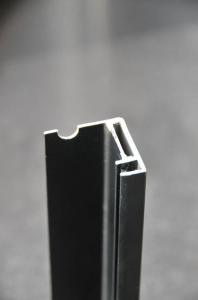Aluminum Tube Profiles for Electronics
- Loading Port:
- China Main Port
- Payment Terms:
- TT OR LC
- Min Order Qty:
- -
- Supply Capability:
- -
OKorder Service Pledge
OKorder Financial Service
You Might Also Like
It mainly consists of those for electric home appliances series, electronics series and electric power series. The aluminum products for electronic industry remain with the high-tech content products; in the middle term of 1990s, the high, medium, low voltage of anode foils & cathode foils entirely rely on the import, consequently it generated a severe influence on competitiveness of the industry, SWA put a great deal of efforts in manpower and material resources to carry out developing and marketing successfully at the end of 1990s, which acquired affirmative comments. The products are applied specifically for buses, stringing, conductors, electrical elements, refrigerators, air-conditioners, cables etc.
Aluminum foil produced by SWA for air-conditioner has good property of deep drawing with high strength and elongation, which has reached the standard of similar imported products.
The Al foil for high performance electrolytic capacitor has been filling a vacancy domestically in China, the integrated quality of products have been approaching or reaching to the world advanced level of similar products.
The Al foils for electrolytic capacitor (1997), the aluminum foil for radiating of air-conditioner (2001) are entitled as “Famous Brand Product of Chongqing”.
- Q: What are the differences between the aluminum profile material and the anodized aluminum profile? Where are they used? If it is necessary to spray the fluorocarbon paint on aluminum, do it on the basis of anodic oxidation or on the aluminum profile material?
- The surface of the material is not oxidized. The oxidized aluminum profile has a smooth and beautiful surface. According to your requirements, choose material
- Q: Tips for identifying aluminum profiles
- First of all, to see whether the aluminum profile has obvious distortion, the surface is smooth and smooth, there is no crack or boldness of vision, scratches, burrs, and if found, some super good, do not buy.Secondly, it is necessary to carefully check the color of aluminum surface, whether there are different shades of color, there is color difference, that is, the quality is not pass.
- Q: Can aluminum profiles be used for lighting fixtures or systems?
- Yes, aluminum profiles can be used for lighting fixtures or systems. Aluminum is a lightweight and versatile material that is commonly used in the construction of lighting fixtures due to its durability, corrosion resistance, and heat dissipation properties. Aluminum profiles can be easily fabricated into various shapes and sizes, making them suitable for different lighting applications such as recessed lighting, track lighting, pendant lighting, and more. Additionally, aluminum profiles can be anodized or coated with different finishes to enhance their aesthetic appeal and protect them from environmental elements. Overall, the use of aluminum profiles in lighting fixtures or systems allows for efficient and effective lighting solutions while maintaining a sleek and modern design.
- Q: How do you cut and shape aluminum profiles?
- To cut and shape aluminum profiles, you can use various methods such as sawing, milling, drilling, or using specialized cutting tools. Sawing can be done with a hacksaw, circular saw, or miter saw, while milling involves using a milling machine to remove material and create desired shapes. Drilling is commonly used to create holes in the aluminum profiles. Additionally, specialized cutting tools like shears or punches can be utilized for specific cutting requirements. It is important to select the appropriate tools and techniques based on the profile's thickness, complexity, and desired outcome. Safety precautions and appropriate protective gear should always be used when working with aluminum.
- Q: Can aluminum profiles be used in the production of signage?
- Yes, aluminum profiles can be used in the production of signage. Aluminum is a versatile material that is lightweight, durable, and resistant to corrosion, making it suitable for outdoor and indoor signage applications. It can be easily cut, shaped, and assembled to create custom signage designs. Additionally, aluminum profiles can provide a sleek and modern aesthetic to signage projects.
- Q: What are the applications of aluminum profiles?
- Due to their unique characteristics and properties, aluminum profiles have a wide range of applications in various industries. Some of the main uses of aluminum profiles are as follows: 1. In the construction industry, aluminum profiles are extensively employed for windows, doors, curtain walls, and structural components. Their excellent strength, durability, and corrosion resistance make them ideal for building purposes. 2. The automotive industry utilizes aluminum profiles to manufacture lightweight and fuel-efficient vehicles. They are used in the production of car frames, engine mounts, heat exchangers, and other structural components. 3. The aerospace industry relies on aluminum profiles for their high strength-to-weight ratio. They are used in the construction of aircraft frames, wings, fuselage, and other critical components. 4. Aluminum profiles are widely used in electrical and electronics applications. Their excellent thermal conductivity and electrical insulation properties make them suitable for manufacturing heat sinks, LED lighting fixtures, electrical enclosures, and electronic device housings. 5. The furniture industry is increasingly incorporating aluminum profiles to create lightweight and stylish furniture pieces. They are used in the production of chairs, tables, cabinets, and shelving systems, providing a modern and aesthetic appeal. 6. Aluminum profiles play a significant role in the manufacturing of industrial machinery and equipment. They are utilized in the construction of conveyor systems, assembly line structures, machine frames, and guarding systems due to their lightweight, durability, and ease of fabrication. 7. In the marine industry, aluminum profiles are commonly used for their corrosion resistance and lightweight properties. They are utilized in the construction of boat frames, masts, hulls, and other marine structures. 8. Aluminum profiles also find applications in renewable energy systems such as solar panels and wind turbines. They are used in the manufacturing of solar panel frames, wind turbine supports, and mounting structures due to their lightweight nature and corrosion resistance. Overall, aluminum profiles offer a versatile and cost-effective solution for various industries, meeting their specific requirements for strength, durability, lightweight, and corrosion resistance.
- Q: What are the different sizes and dimensions of aluminum profiles?
- The different sizes and dimensions of aluminum profiles can vary greatly depending on the specific application and manufacturer. They can range from small, narrow profiles with dimensions of a few millimeters to larger, wider profiles with dimensions of several inches or more. The length of the profiles can also vary, typically ranging from a few feet to several meters.
- Q: This question asks about the various types of aluminum profiles that are specifically used in roof insulation systems.
- <p>Aluminum profiles for roof insulation systems are designed to provide structural support and thermal insulation. Common types include: 1) U-channels, which are used as support beams; 2) C-profiles, used for connecting and securing insulation boards; 3) H-profiles, serving as main rafters or purlins; 4) Z-profiles, often used as secondary rafters or for sealing; 5) T-profiles, used for creating airtight seals at the edges; and 6) L-profiles, which can be used for corner reinforcements. These profiles come in various sizes and thicknesses to suit different roofing specifications and insulation requirements.</p>
- Q: What are the design options for aluminum profiles?
- The design options for aluminum profiles are extensive and versatile. They can be customized in terms of shape, size, and finish, allowing for a wide range of possibilities. Some design options include different cross-sectional shapes like square, rectangular, and circular profiles, as well as various surface finishes such as anodized, powder-coated, or polished. Additionally, aluminum profiles can be further modified with additional features like grooves, slots, or channels to accommodate specific assembly or mounting requirements.
- Q: Are aluminum profiles suitable for food processing or storage facilities?
- Yes, aluminum profiles are suitable for food processing or storage facilities. Aluminum is a highly versatile material that offers several advantages in these environments. Firstly, aluminum is corrosion-resistant, ensuring that it remains unaffected by moisture, food acids, or cleaning agents commonly used in food facilities. This makes it ideal for use in areas where hygiene and cleanliness are crucial. Secondly, aluminum profiles are lightweight yet sturdy, making them easy to handle and install. This is especially beneficial in food processing facilities where regular equipment maintenance and reconfigurations are required. Additionally, aluminum is a non-toxic material, ensuring that it does not contaminate food products during processing or storage. It is also an excellent conductor of heat, allowing for efficient temperature control in processing facilities. Furthermore, aluminum profiles can be easily cleaned and sanitized, reducing the risk of bacterial growth and ensuring compliance with food safety regulations. Overall, the durability, corrosion resistance, lightweight nature, non-toxicity, and ease of maintenance make aluminum profiles an excellent choice for food processing or storage facilities.
Send your message to us
Aluminum Tube Profiles for Electronics
- Loading Port:
- China Main Port
- Payment Terms:
- TT OR LC
- Min Order Qty:
- -
- Supply Capability:
- -
OKorder Service Pledge
OKorder Financial Service
Similar products
Hot products
Hot Searches
Related keywords
